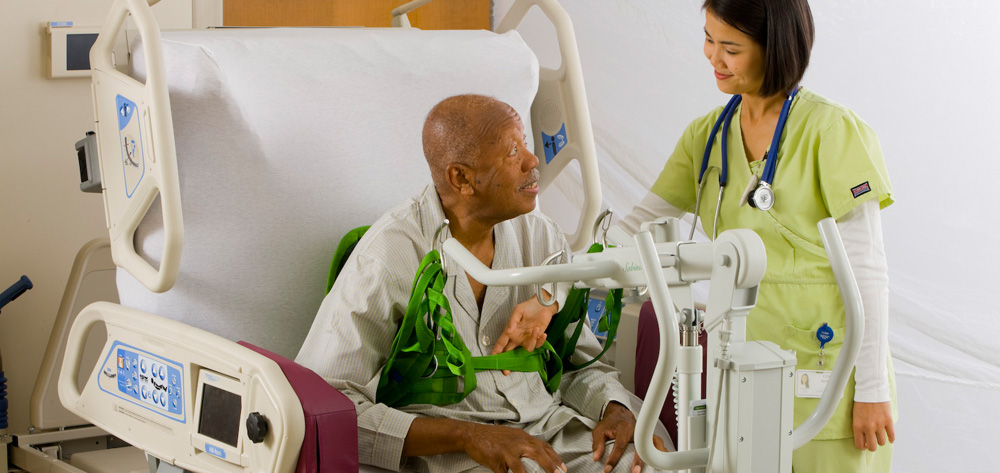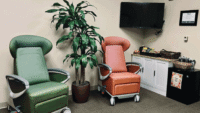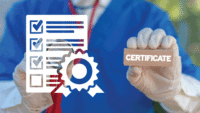To avoid injuring their patients and themselves, healthcare providers must get in the habit of using safe patient handling and mobility (SPHM) technology. In this supplement, national experts share their perspectives and best practices on topics ranging from dealing with bariatric patients, managing slings, and assessing a patient’s mobility to transforming the culture, building the business case for an SPHM, and developing a successful SPHM program.
Download a PDF of the entire supplement here.
A patient’s mobility status affects treatment, handling and transfer decisions, and potential outcomes (including falls). Hospital patients spend most of their time in bed—sometimes coping with inadvertent negative effects of immobility. Assessing a patient’s mobility status is crucial, especially for evaluating the risk of falling. Yet no valid, easy-to-administer bedside mobility assessment tool exists for nurses working in acute-care settings.
Various safe patient handling and mobility (SPHM) technologies allow safe transfer and mobilization of patients while permitting maximum patient participation and weight-bearing (if indicated). A mobility assessment helps identify the SPHM technology needed to ensure safe activities while taking the guesswork and uncertainty out of deciding which SPHM technology is right for which patient.
Because mobility is so important during hospitalization, members of a Banner Health multidisciplinary SPHM team determined nurses should take a more active role in assessing and managing patient mobility. We concluded it was crucial to develop and validate a tool that nurses can use easily at the bedside to assess a patient’s mobility level and the need for SPHM technology. For both patient and staff safety, a patient’s mobility level must be linked with use of SPHM technology. When used consistently, appropriate technology reduces the risk of falls and other adverse patient outcomes associated with immobility. (See The link between patient immobility and staff injuries.)
Communication barriers
Historically, mobility assessments and management have been under the purview of physical therapists (PTs) through consultations. But the entire healthcare team needs to address patient mobility. Nurses conduct continual surveillance of patients and their progress, but typically they haven’t performed consistent, validated mobility assessments. Instead, they’ve relied on therapy services to determine the patient’s mobility level and management.
In many cases, though, a PT’s assessment doesn’t translate to meaningful actionable items for nurses. What’s more, PTs don’t always adequately communicate a patient’s SPHM needs to other healthcare team members. For example, confusion surrounds terminology typically used by PTs, such as numeric mobility levels (1+, 2+, indicating a one-person or two-person assist, respectively) as well as ranges (minimum, moderate, or maximum assist by one or more healthcare workers). Also, PTs are consulted only for a limited number of patients and at different points during the hospital stay. Nurses, for their part, aren’t trained in skilled therapy techniques and may be ill prepared to mobilize patients safely during routine daily activities.
In addition to communicating potential risk to other healthcare team members, mobility assessment can identify technology needed to perform SPHM. Especially if PTs aren’t available, nurses must rely on their own judgment to move and mobilize patients safely. But they may be uncertain as to which equipment to use for which patients. While a total lift may be used with many patients, such a lift doesn’t maximize the patient’s mobility potential.
Current mobility assessment options
Although tools to assess mobility and guide SPHM technology selection are used in hospitals, their value for the bedside nurse may be limited or inappropriate with many patients in acute-care settings. SPHM algorithms from the Department of Veterans Affairs have been valuable as training and decision-making tools in determining which SPHM technology to consider for specific tasks. But these can be hard to use at the bedside. Also, they assume the patient’s mobility status is known and don’t provide quick guidance in determining a patient’s overall mobility level. (See Limitations of common mobility assessment tools.)
Banner Mobility Assessment Tool
At Banner Health, we developed the Banner Mobility Assessment Tool (BMAT) to be used as a nurse-driven bedside assessment of patient mobility. It walks the patient through a four-step functional task list and identifies the mobility level the patient can achieve (such as mobility level 1). Then it guides the nurse to the recommended SPHM technology needed to safely lift, transfer, and mobilize the patient. (See Banner Mobility Assessment Tool for nurses.)
Implementing BMAT
The BMAT was created in our hospital’s electronic medical record (EMR) in a way that guides the nurse through the assessment steps. Patients are determined to have a mobility level of 1, 2, 3, or 4 based on whether they pass or fail each assessment level. Educational tools and tip sheets are used to train nurses and support staff on what technology to consider for patients at each level.
Communication tools also are used. For instance, a sign outside the patient’s room indicates his or her mobility level, instantly telling anyone passing by or entering if the patient can ambulate independently or if SPHM technology must be used. To stay current on the patient’s mobility status (for instance, at handoffs, after procedures, with medication changes, or after a potentially tiring therapy session), nurses are expected to complete the BMAT on admission, once per shift, and with the patient status changes. The BMAT also is linked to Banner’s fall assessment risk in the EMR.
Throughout BMAT implementation, we recognized that identifying a patient’s mobility level and fall risk score are pointless unless appropriate interventions are implemented and the outcomes evaluated. Nurses need to be empowered and able to recognize the connection between these assessments and choice of interventions, including SPHM technology.
Here’s an example of BMAT in action at Banner: A 35-year-old male was admitted to a surgical floor late in the evening. He was 6’2″ tall and weighed 350 lb (158 kg). He didn’t want to use a bedpan, but his nurse wasn’t comfortable getting him up to use the bathroom because he hadn’t been evaluated by physical therapy, and a PT wasn’t available in the evening. A nurse passing by who’d used the BMAT (which hadn’t been formally rolled out Banner-wide at that time) came in and assessed the patient; the assessment found him at mobility level 3. He was transferred to the toilet using a nonpowered stand aid. Both patient and nurse were relieved and happy.
A step in the right direction
As a quick bedside assessment tool, the BMAT is a step in the right direction. It’s part of a broad program of increased staff awareness, education, and training around patient assessments, preventing staff injuries and patient falls, and achieving better patient outcomes. Initial evidence from a validation study completed at one Banner hospital supports the BMAT as a valid instrument for assessing a patient’s mobility status at the bedside.
As we work toward customizing actions and interventions to meet individual patient needs, we continue to evaluate which additional assessment components or fall interventions or precautions are needed or require greater focus. Although we know nurses should be more involved in assessing mobility than they have been historically, we recognize the value of involving and communicating effectively with all members of a good interdisciplinary team to help reduce patient falls and staff injuries caused by patient handling.
Selected references
Dionne M. Practice Management: Stand and deliver. Physical Therapy Products. March 2005. Accessed June 30, 2014.
Hook ML, Devine EC, Lang NM. Using a computerized fall risk assessment process to tailor interventions in acute care. In: Henriksen K, Battles JB, Keyes MA, Grady ML, eds. Advances in Patient Safety: New Directions and Alternative Approaches; vol 1. Assessment. AHRQ Publication No. 08-0034. Rockville, MD: Agency for Healthcare Research and Quality; 2008. www.ncbi.nlm.nih.gov/books/NBK43610. Accessed July 10, 2014.
Mathias S, Nayak US, Isaacs B. Balance in elderly patients: the “get-up and go” test. Arch Phys Med Rehabil. 1986;67(6):387-9.
Oliver D, Healey F. Falls risk prediction tools for hospital inpatients: do they work? Nurs Times. 2009;105(7):18-21.
Oliver D, Healey F, Haines TP. Preventing falls and fall-related injuries in hospitals. Clin Geriatr Med. 2010;26(4):645-92.
Nelson AL. Safe patient handling and movement: A guide for nurses and other health care providers. New York, NY: Springer Publishing Company, Inc.; 2006. www.springerpub.com/samples/9780826163639_chapter.pdf. Accessed June 30, 2014.
Nelson A, Harwood KJ, Tracey CA, Dunn KL. Myths and facts about safe patient handling in rehabilitation. Rehabil Nurs. 2008;33(1):10-7.
Wright B, Murphy J. “Quick-5 Bedside” Guide. Franklin, MA: Liko, Inc.; 2005.
Teresa Boynton is an injury prevention and workers’ compensation consultant, ergonomics specialist, and certified safe patient handling professional for Risk Management at Banner Health, Western Region, based in Greeley, Colorado. Lesly Kelly is the RN clinical research program director for Banner Good Samaritan Medical Center in Phoenix, Arizona. Amber Perez is a safe patient handling clinical consultant for Handicare North America based in Phoenix, Arizona.


















5 Comments.
Who at Banner Health Developed the BMAT – I want to cite the original source of the BMAT
I would like to read these two articles
Is the BMAT tool in the public domain so any health care system can be used
Do I need permission to use BMAT in my hospital? Thank you
Is there contact information for the author of this article?